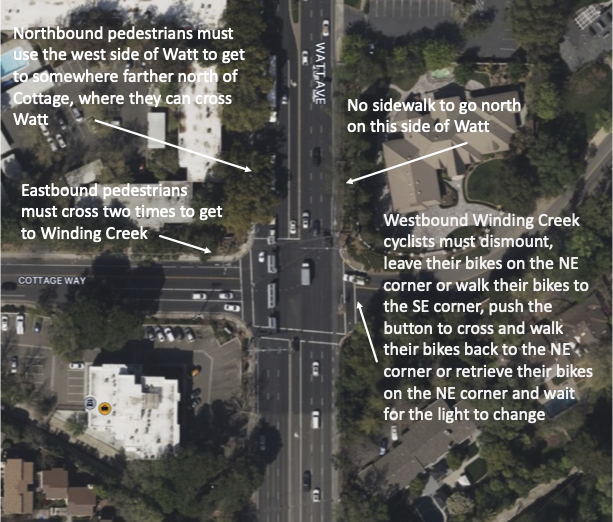Another well-meaning, misleading Bee editorial
Supervisor Rich Desmond held the final session of his potholes listening tour recently. It was in Rancho Cordova, a south-of-the-river part of his district that he shares with Supervisor Pat Hume of Elk Grove. The Bee sent Ms. Robin Epley to the meeting, which led her to pen an editorial ("As Sacramento’s roads crumble, our addiction to car culture worsens climate change", Sacramento Bee, July 21, 2023). It's behind a paywall, so our Newsroom Elves have taken it upon themselves to highlight it here for you.
The Supervisors and their Transportation Department chief, Ron Vicari, gave pretty much the same pitch they gave at the other stops on the listening tour: the County let its road maintenance backlog run amok, SACOG's grant money isn't aligned with local needs, but some projects are moving forwards and, hopefully, things will stop getting worse someday. The editorial 's discomfort with all that was well aimed. The County has indeed dropped the ball and it is mighty late in the game to be trying to fix it. The editorial also accurately states that the County is responsible for providing municipal services to unincorporated areas. However, though correctly citing Supervisor Desmond for saying the County isn't up to the job, the editorial , apparently not really understanding the situation, went on to scold the county and its unincorporated nobodies for failing to get with the program and give up our cars.
Counties were never established to do a good job to provide those municipal servicesSupervisor Rich Desmond, quoted in Robin Epley, "As Sacramento’s roads crumble, our addiction to car culture worsens climate change", Sacramento Bee, July 21, 2023
There are several factors that either Ms. Epley or her Editorial Board bosses/editors left out of the editorial. The most obvious one is that here in the unincorporated urban jungle, we do not have mobility choices other than cars. It's just been so easy for the County and its laissez faire approach to growth and development to just look the other way so developers can do whatever they want. Under the umbrella of a 40-year-old "plan" for the community, hiding behind Post-Prop-13 "fiscal zoning" that favored rampant commercial development, the County let our stagnant housing stock decline. Infrastructure money was spent anywhere except here. The light rail "system", built without a public hearing in the ridership area, wound up on the wrong side of our bottlenecks. The investment satisfied the Modern Transit Society (which wanted a trolley, never mind the need), Caltrans (which got a linear transportation project when its road money was cut), the Downtown Sacramento Power Elite (because every "real" city has an NBA franchise and rail transit), and both the City of Sacramento and the County of Sacramento (which got a maximum amount of state and federal dollars for a minimum amount of local funds). Who wasn't satisfied? Potential transit riders, who quickly learned it was faster and more convenient to keep driving to work.
Some other aspects that the editorial should have explored before just shaming us for using cars:
- our very significant lack of sidewalks, particularly on major streets
- for those few places where we do have sidewalks, there is an abundance of "rolled-curb" designs that are hazardous to pedestrians,
- the characteristically narrow width of the few sidewalks we have, which are not wide enough for two people to pass without someone stepping aside,
- much of our limited sidewalk space is taken up by telephone poles and utility boxes,
- our absence of protected bike lanes,
- the County's apparent preference for bike lanes on very busy streets - unswept and cambered into the gutter - that place cyclists in danger from speeding vehicles,
- our utter lack of any kind of bicycle-friendly infrastructure - convenient, lockable racks at places like grocery stores, safe bike parking and showers at workplaces, etc.,
- our thoroughly inadequate bus service with long headways (waiting time between buses) and significantly reduced service nights and weekends, and
- our inhospitable (typically no shade, no benches, no roofs) bus stops.

The editorial goes on to extol the virtues of "complete streets" that are preferred by SACOG. Indeed, such infrastructure checks boxes as a climate change tactic. The editorial then wisely avoids saying where any such streets can be found in our immediate vicinity (hint: we don't have any here). What we DO have - in spades - is potholes. People here do not like the abundant, ubiquitous potholes that help keep Fulton Avenue's suspension repair shops in business, but it's not like there are other valid choices. Is that really just a car culture problem?
And, finally, the editorial suggests a solution that seems detached from reality: tap into the deep pockets of developers for the $1,000,000,000+ it will take to re-make our community as a mobility Eden. Companies like Buzz Oates, AKT/Tsakopoulos, Petrovich and others will no doubt love that idea. Region Builders will beg for it, too. Uh, no, not really. Beyond that, the editorial totally failed to notice the elephant in the room - the concept of incorporation of our intensely urbanized unincorporated area, such that local people could control use of their tax dollars for local priorities - like, you know, potholes and sidewalks and safe biking - and also have a seat on the key groups in charge of transportation money (SACOG) and transit services (RT).
Overall, we are happy that the Bee found it worthwhile to send an editorial board person to Supervisor Desmond's event and we are grateful for the honest reporting about the County's shortcomings. We also understand the overall need to move away from car dependency. On the other hand, we are uncertain that the Bee has even the faintest understanding of our actual situation and we think the proposed solution is a non-starter. So we'll give the editorial 3 1/2 points out of 5 and hope they keep trying.
